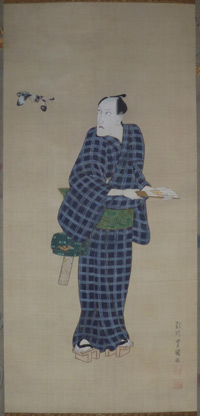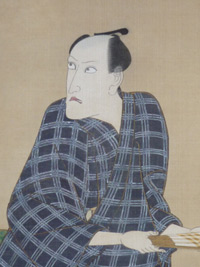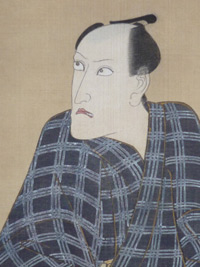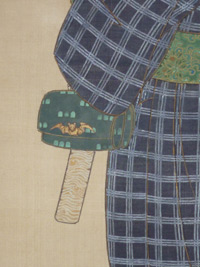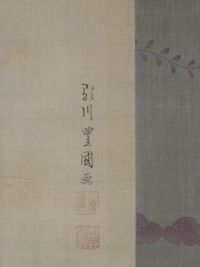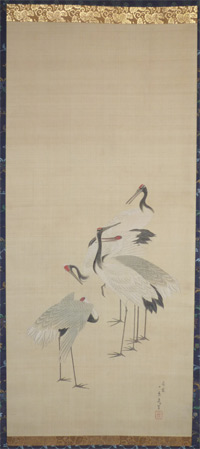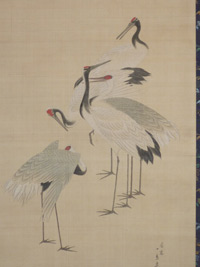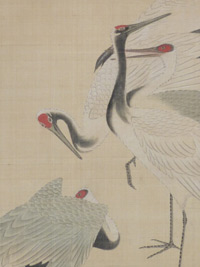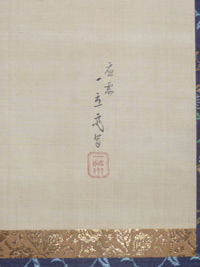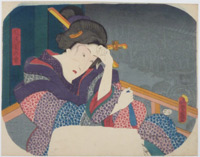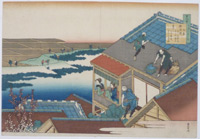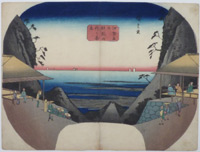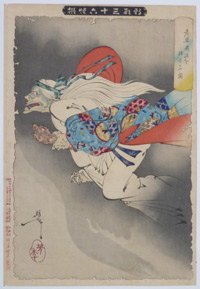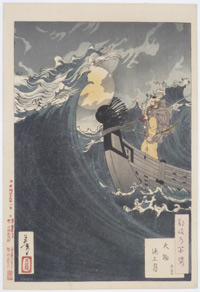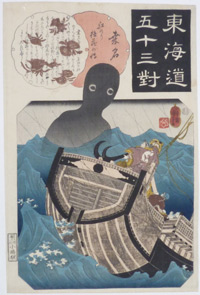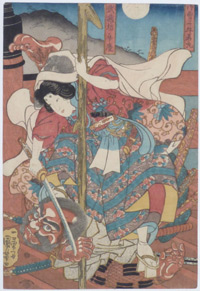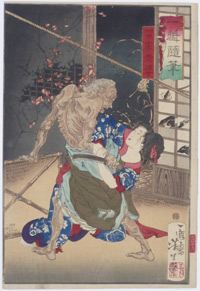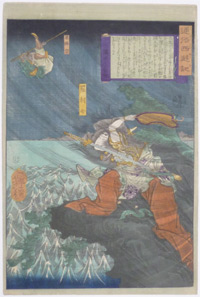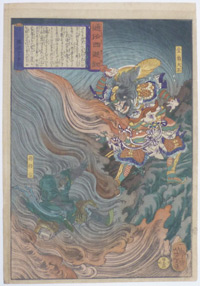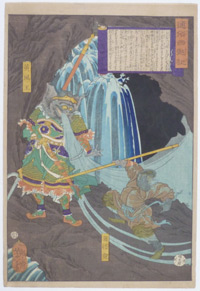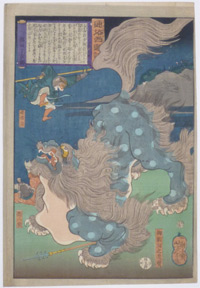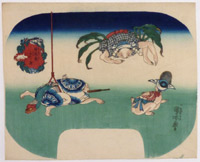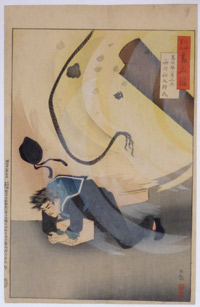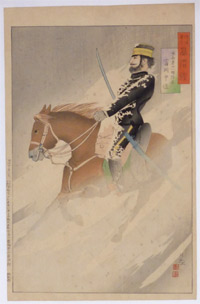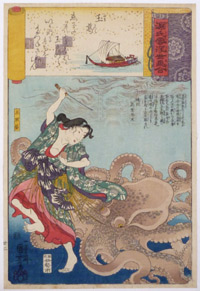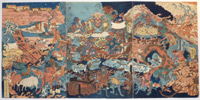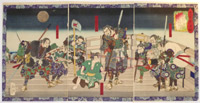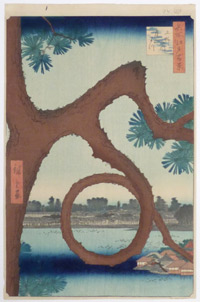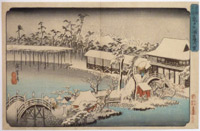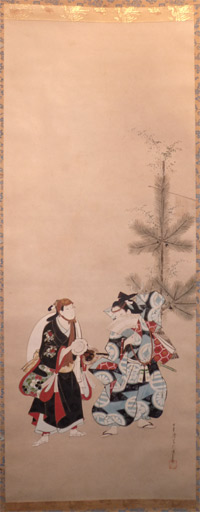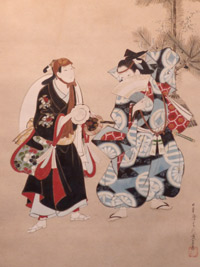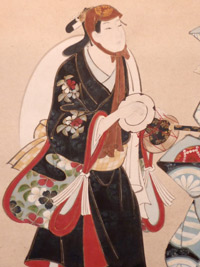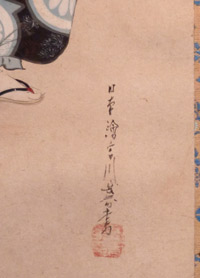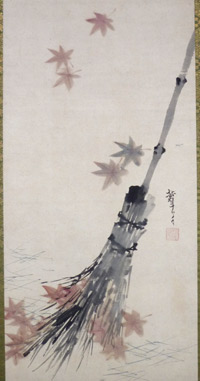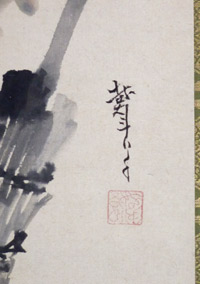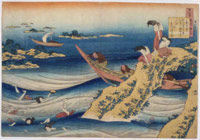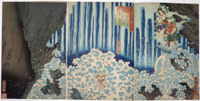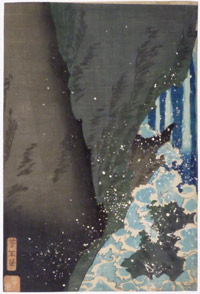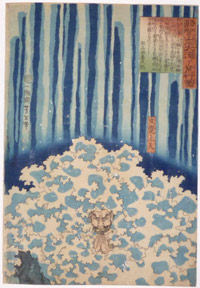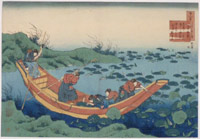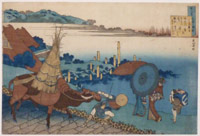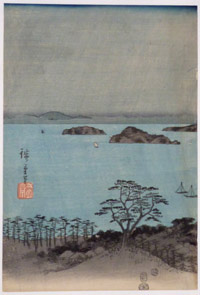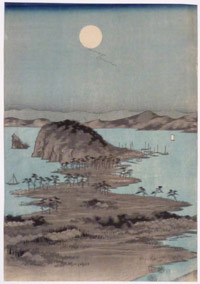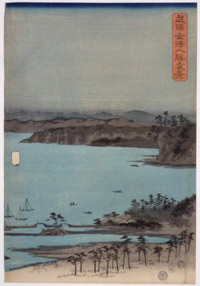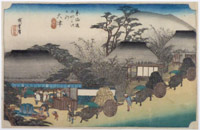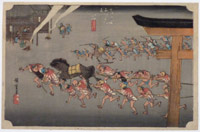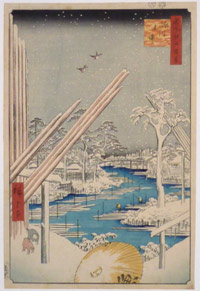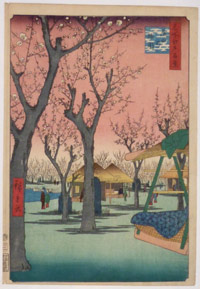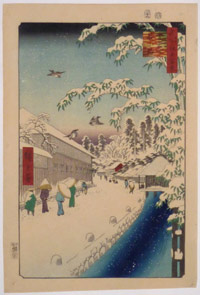Utagawa TOYOKUNI I (1769-1825)
Click here to view image full size.
An important painting: Nanadaime Danjuro sugata-e, “Portrait of Danjuro VII.” Painted at the end of the Bunka period ( c. 1815 ), it shows the young Danjuro after his succession. He wears the Danjuro mimasugoshi, Danjuro’s triple-plaid kimono pattern. His favourite tobacco pouch with the bat-shaped catch is hanging at his waist. He is looking at two butterflies. An allusion to the famous story of Zhuang Zhou who dreams of being a butterfly, only to wake and wonder if he is, in fact, not a butterfly dreaming of being Zhuang Zhou. The story symbolizing the evanescence of life. A similar painting of Nakamura Utaemon II dated 1812 is in the Museum of Fine Arts, Boston, acc. No. 11.7864. Full colour on silk. Image size 23.25 x 11 inches; 59 x 28 cms. Two repaired wormholes not affecting image, otherwise very good condition. Interesting old embroidered and hand-painted mount. Signed Utagawa Toyokuni ga with seals Ichiyosai and Toyokuni.
Status: Sold
Utagawa HIROSHIGE (1797-1858)
Click here to view image full size.
A fine and rare painting: Gunkaku zu, “A Flock of Cranes.” Hiroshige designed many fine kachoga during the 1830s through to the 1850s but there exist few paintings. This was a commissioned work from Hiroshige. The tancho ( “red crest” ) Japanese Crane, Grus japonensis, is the second rarest crane in the world, migrating to East Asia in the fall to spend the winter. There is also a resident flock in Hokkaido. Much loved by the Japanese, the crane was a symbol of luck, longevity and fidelity. Full colour on silk, image size 34.5 x 15.75 inches; 88 x 40 cms. In perfect condition with a futo-maki ( thick wooden roll to preserve the painting from damage ). New box. Signed Ojyu ( “commissioned” work ) Ichiryusai hitsu. ( A rare form of the signature used c. Tenpo 10 to 11 [ around 1839 – 40 ]. ) The Ichiryusai seal is also a rare form used around mid Tenpo period.
Status: Sold
Utagawa KUNISADA (1786-1864)
Click here to view image full size.
An uncut fan print with title: Furyu yami no kaori, “A Refined Date in the Dark.” Shows a beauty holding a pipe and contemplating a dusky garden and her hidden lover. From a set published by Kojimaya Jubei, with date seal 3/1852.
Fine impression and colour. Small paper fibre on woman’s cheek, otherwise fine condition. Signed Konomi ni ujite ( “With my taste” ) Toyokuni ga.
Status: Sold
Katsushika HOKUSAI (1760-1849)
Click here to view image full size.
A poem by the Lady of Ise which speaks of a love that has not been reciprocated. From Hyakunin isshu uba ga etoki, the “Hundred Poems Explained by the Wet Nurse.” Published by Eijudo and Iseri, c.1835-6. Although obviously intended to be a set of 100 prints, only 27 are known plus drawings for others. The scene shows two ladies looking out over the rice fields to the Naniwa Inlet ( the ancient name for the region around Osaka ). The house is either being built or repaired with new tiles to the roof.
Exceptionally early impression with beautiful printing. This appears to be the earliest state with gradation on the roof bottom right and down from the top. Fine colour. Full size. Very slight centre fold, otherwise very good condition. Signed Zen Hokusai manji.
Status: Sold
Ichiryusai HIROSHIGE (1797-1858)
Click here to view image full size.
An uncut fan print from a set of views in Ise: Ise meisho, Asakumayama toge no chamise, “Teahouses on the Mount Asakuma Pass, Famous Places of Ise Province.” Hiroshige used this view about a decade later for his oban tata-e set The 60-Odd Provinces. He cleverly uses the cliff sides to wrap around the uchiwa-e shape. Published c. 1840. Extremely rare. This actual impression illustrated in Hiroshige no uchiwa-e, Unsodo 2010, p. 78, pl. 108. Ex collection Maroni, seal at bottom.
Fine impression and colour. Centre fold, as often, otherwise very good condition. Signed Hiroshige ga.
Status: Sold
Tsukioka YOSHITOSHI (1839-1892)
Click here to view image full size.
Roba kiwan o mochisaru zu from Shinkei sanjurokkaisen, “New Forms of Thirty-six Ghosts.” The best design from the set published by Sasaki Toyokichi, 1889. This famous story recounts how Watanabe no Tsuna cuts off the arm of the demon Ibaraki at the Rashomon Gate, Kyoto in 976. He secretes the arm away in a box. Subsequently he is visited by his wet-nurse ( or aunt – depending on which version you read ) who convinces him to show it to her. Instantly she snatches the arm and flies off revealing herself to be Ibaraki in disguise. The story became the famous no play Ibaraki. Ex John Stevenson collection.
Fine impression and colour. The first edition. Slight edge crease on left border, otherwise very good condition. Signed Yoshitoshi.
Status: Sold
Tsukioka YOSHITOSHI (1839-1892)
Click here to view image full size.
The best design from the set Tsuki hyakushi, the “Hundred Phases of the Moon”. The set published between 1885 and 1892 ( this being 1886 ) by Akiyama Buemon. Benkei against a full moon. In 1185 Yoshitsune attacked by his half-brother Minamoto no Yoritomo, was forced to flee to northern Japan by ship. Sailing along the Inland Sea off the coast of Harima Province not far from Kyoto, the ship was struck by a storm in Daimotsu Bay caused by the vengeful ghosts of the Taira warriors Yoshitsune and his men had slain. Benkei pacified the spirits in the prow of the boat.
Fine impression, colour and condition. An impression that has not been in an album: Full margins with very extensive mica. Signed Yoshitoshi.
Status: Sold
Ichiyusai KUNIYOSHI (1797-1861)
Click here to view image full size.
The apparition of the Sea Monk, Umibozu, looming above the sailor Kawanaya Tokuzo. The best design from Tokaido gojusan tsui, Station 41, Kuwana. The legend has it that Tokuzo, against the advice of his peers, went to sea on the last day of the year. He subsequently experienced huge seas and the monster who demanded to know what was the most horrible thing he knew. He replied that his profession was the most horrid. Satisfied, the creature descended into the Stygian gloom and the storm abated. Published by Kojima-ya Jubei, c. 1845. Illustrated in Robinson, Kuniyoshi, HMSO, 1961, no. 49.
Fine, early impression with the light blue on the sea. Fine colour. Expert remargin at bottom but retaining black border. Signed Ichiyusai Kuniyoshi ga.
Status: Sold
Ichiyusai KUNIYOSHI (1797-1861)
Click here to view image full size.
Musashi-bo Benkei overcome by Onzoshi Ushiwaka Maru on Gojo Bridge under a full moon. Benkei was enormously tall and strong and had defeated many challengers on the bridge in Kyoto. However, he met his denouement in Yoshitsune who, although much smaller, was a fencing master. He is shown holding Benkei down with his geta, sword and large stave. From a rare set published by Tsuta-ya Kichizo, c. 1843. Robinson S1f 3.
Very good impression and colour. Slight trimming all round, otherwise very good condition. Signed Ichiyusai Kuniyoshi ga.
Status: Sold
Ichiyusai KUNIYOSHI (1797-1861)
Click here to view image full size.
A triptych showing the Soga Brothers’ last stand in the rain on Suso Moor under Mount Fuji. Fuji no Suso-no Soga kyodai hommo wo togeru zue. Published by Yamaguchi-ya Tobei, c. 1845. A subject covered by many artists. Illustrated in Robinson, Kuniyoshi, HMSO, 1961, no. 44.
Very good impression and colour. Slightly trimmed at bottom, otherwise very good condition. Signed Ichiyusai Kuniyoshi ga.
Status: Sold
Tsukioka YOSHITOSHI (1839-1892)
Click here to view image full size.
The old hag of the Lonely House. A gruesome subject: The evil witch is intent on cutting open the pregnant woman’s belly to get at the unborn child whose blood she needs for a magic potion. From Ikkai zuihitsu, “Essays by Yoshitoshi.” A set of 13 prints published by Masadaya in 1872. There are numerous variations in seals in this fine set but, as yet, no research has been done into their significance.
Very fine impression and colour. Trimmed close on the left but retaining black border. Retains original album backing. Signed Ikkaisai Yoshitoshi hitsu.
Status: Sold
Tsukioka YOSHITOSHI (1839-1892)
Click here to view image full size.
Yamauba and Kaidomaru from Ikkai zuihitsu, “Essays by Yoshitoshi.” A set of 13 prints published by Masadaya in 1872 ( this design being 1873 ). Shows the mother and son ( also known as Kintaro ). He of the enormous strength is often shown acting as umpire at a wrestling match between a hare and a monkey. The Madonna-like figure here is one of the few Yoshitoshi designs to borrow heavily from western art. There are numerous variations in seals in this fine set but, as yet, no research has been done into their significance.
Very fine impression and colour. There is an alternate version of this print with Kintaro printed in a light brown. Trimmed close on the left but retaining black border. Retains original album backing. Signed Ikkaisai Yoshitoshi hitsu.
Status: Sold
Tsukioka YOSHITOSHI (1839-1892)
Click here to view image full size.
The monkey of phenomenal powers Sun Wukong battles Kinkaku Daio on a sea cliff. From a fine, rare and early set of at least 21 designs: Tsuzoku saiyuki, “Journey to the West” published by Fukuta between 10/1864 and 8/1865, this being 12/1864. The story covers the journey of Son Goku ( Chin. Sun Wukong ) a.k.a. The Monkey King to India, accompanying Xuanzang, to retrieve the Buddhist sutras. Sun Wukong, born from a stone, had supernatural powers; possessed enormous strength; could transform himself into other people and objects, and cover large distances in a single flip. The story covers 100 chapters and there are a multitude of characters and events. A fine design.
Fine impression. Minimal soil and fading. Signed Ikkaisai Yoshitoshi hitsu.
Status: Sold
Tsukioka YOSHITOSHI (1839-1892)
Click here to view image full size.
The monkey of phenomenal powers Sun Wukong battles a warrior ( Rakijo ? ) on a precipitous cliff over a choppy sea. From a fine, rare and early set of at least 21 designs: Tsuzoku saiyuki, “Journey to the West” published by Fukuta between 10/1864 and 8/1865, this being 12/1864. The story covers the journey of Son Goku ( Chin. Sun Wukong ) a.k.a. The Monkey King to India, accompanying Xuanzang, to retrieve the Buddhist sutras. Sun Wukong, born from a stone, had supernatural powers; possessed enormous strength; could transform himself into other people and objects, and cover large distances in a single flip. The story covers 100 chapters and there are a multitude of characters and events. A fine design.
Fine impression. Minimal soil and fading. Signed Ikkaisai Yoshitoshi hitsu.
Status: Sold
Tsukioka YOSHITOSHI (1839-1892)
Click here to view image full size.
The monkey of phenomenal powers Sun Wukong battles Kofuo, the wind demon who had captured Genjosanzo. From a fine, rare and early set of at least 21 designs: Tsuzoku saiyuki, “Journey to the West” published by Fukuta between 10/1864 and 8/1865, this being 12/1864. The story covers the journey of Son Goku ( Chin. Sun Wukong ) a.k.a. The Monkey King to India, accompanying Xuanzang, to retrieve the Buddhist sutras. Sun Wukong, born from a stone, had supernatural powers; possessed enormous strength; could transform himself into other people and objects, and cover large distances in a single flip. The story covers 100 chapters and there are a multitude of characters and events. A fine design.
Fine impression. Minimal soil and fading. Signed Ikkaisai Yoshitoshi hitsu.
Status: Sold
Tsukioka YOSHITOSHI (1839-1892)
Click here to view image full size.
The monkey of phenomenal powers Sun Wukong battles an enormous polka dot shishi lion. Shidado no roma. From a fine, rare and early set of at least 21 designs: Tsuzoku saiyuki, “Journey to the West” published by Fukuta between 10/1864 and 8/1865, this being 12/1864. The story covers the journey of Son Goku ( Chin. Sun Wukong ) a.k.a. The Monkey King to India, accompanying Xuanzang, to retrieve the Buddhist sutras. Sun Wukong, born from a stone, had supernatural powers; possessed enormous strength; could transform himself into other people and objects, and cover large distances in a single flip. The story covers 100 chapters and there are a multitude of characters and events. A fine design.
Fine impression. Minimal soil and fading. Signed Ikkaisai Yoshitoshi hitsu.
Status: Sold
Ichiyusai KUNIYOSHI (1797-1861)
Click here to view image full size.
An uncut fan print of the utmost rarity with title E-kyodai awase kagami. An impossible title to translate but something like Disparate Images as Opposing Mirrors. Another from this set is illustrated in Juzo Suzuki, Kuniyoshi, 1992, pls. 421 and 422 ( from Merlin Dailey collection and also illustrated in Exhibition Of Ukiyo-e By Kuniyoshi, Riccar Art Museum, 1978, pls. 254 and 255, and elsewhere ). And another two designs are illustrated in the new Nikkei/Mori Arts Center Kuniyoshi catalogue, nos 321 and 322. These humorous prints show figures in contorted positions which, when seen in silhouette, reveal themselves as animals, crustaceans or fish. Two prints were published: as here, and the silhouette which was stuck on the reverse of the fan. The figures on this print become, in silhouette, a crab, a tortoise, and a Tosakin goldfish. I have been unable to locate another illustrated impression of this print and it may well be the only known example. Published c. late 1840’s probably by Ibaya Sensaburo as the other design from this set has this publisher’s seal.
Very fine impression, colour and condition. Mint. Signed Ichiyusai Kuniyoshi giga.
Status: Sold
Kobayashi KIYOCHIKA (1847-1915)
Click here to view image full size.
Shows ordinary seaman Nishikawa Hatsutaro of the corvette Katsuragi which saw action during the Sino-Japanese war ( 1/7/1894-17/4/1895 ). He appears to be saving something by covering it with his body. From a set Rikukaigunjin komei kagami, “Mirror of Army and Navy Heroes.” Published by Inoue Kichijiro, 2/1895. For whatever reason, a rare set. Fine design.
Fine impression and colour. Signs of mounting au verso, otherwise fine condition. Signed Kiyochika.
Status: Sold
Kobayashi KIYOCHIKA (1847-1915)
Click here to view image full size.
Shows Lieutenant Colonel Tomioka Sanzo charging on horseback. He was the commander of the 22nd infantry regiment during the Sino-Japanese war ( 1/7/1894-17/4/1895 ). From a set Rikukaigunjin komei kagami, “Mirror of Army and Navy Heroes.” Published by Inoue Kichijiro, 2/1895. For whatever reason, a rare set. Fine design.
Fine impression and colour. Signs of mounting au verso, otherwise fine condition. Signed Kiyochika.
Status: Sold
Ichiyusai KUNIYOSHI (1797-1861)
Click here to view image full size.
The best design from Genji kumo ukiyoe awase, “Ukiyoe Comparisons of the Cloudy Chapters of Genji.” A set comparing famous warriors to the Chapters of the Genji Monogotari ( Tale of Genji ) written by Lady Murasaki Shikibu ( c 973 – 1025 ). This design is for Chapter 22, Tamakatzura. Shows the pearl diver, Tamatori-hime, who has reclaimed the precious pearl stolen by the Dragon King. She is pursued by a host of his aquatic retainers including a giant octopus before finally returning the jewel to her husband Fujiwara no Kamatari, albeit buried in her chest for safety and causing her death. A popular subject with Kuniyoshi who designed a number of other oban prints and triptychs on the subject. The Dragon King’s palace can be seen beneath the waves in the background. Published by Iseya Ichibei, 1843-5.
Very good impression, colour and condition. Each sheet lightly attached. Signed Ichiyusai Kuniyoshi ga.
Status: Sold
Ichiyusai KUNIYOSHI (1797-1861)
Click here to view image full size.
A vision of hell. In the centre sits Enma, King of Hell, dressed as a Chinese official flanked by minions. He sits in judgement deciding whether a deceased person had been good or bad. Those found wanting are subjected to horrendous tortures, miscreants being boiled, crushed, burnt or having their tongues pulled out. Mothers in Japan were known to threaten naughty children with a visit from Enma. Kuniyoshi is known to have owned a “hell” garment which he had painted and is often pictured wearing it. Published by Tsutaya Kichizo c. mid 1830’s. Rare. Another example illustrated in the new Nikkei/Mori Arts Center Kuniyoshi catalogue, no 111.
Very good impression, colour and condition. Each sheet lightly attached. Signed Ichiyusai Kuniyoshi ga.
Status: Sold
Tsukioka YOSHITOSHI (1839-1892)
Click here to view image full size.
A rare triptych Toyotomi shoshinroku, “A Record of the Advancement of Toyotomi Hideyoshi.” Shows the young Hideyoshi ( 1537 – 1598 ) demanding an apology from Hachisuka Koroku on Yahagi Bridge. Published c. 1869 by Yorozumago.
Fine impression and colour. Gauffrage and extensive burnishing. The paulownia border intact which is often trimmed. Signed Ikkaisai Yoshitoshi hitsu.
Status: Sold
Utagawa KUNISADA (1786-1865)
Click here to view image full size.
An apparently unrecorded horizontal diptych, each panel measuring 6.5 x 15 in; 16.5 x 38 cms. Two groups meet in a snowy landscape and the children, boys on left and girls on right, start a snowball battle. An early surimono-style design, published c 1826-7. Publisher unread ( Kagaya Kichibei ? ) A beautiful rarity.
Fine impression. Extremely good colour. Slight vertical folds, otherwise very good condition. Untrimmed, with ample space for joining. Signed Kunisada ga.
Status: Sold
Ichiryusai HIROSHIGE (1797-1858)
Click here to view image full size.
The Moon Pine, Ueno, Ueno sannai tsuki no matsu from Edo meisho hyakkei, “The Hundred Famous Views of Edo.” Published by Uoya Eikichi between Ansei 3 and 5 ( 1856 – 58 ), this design being Snake 8 ( 1857 ). Shows Shinobazu Pond, Ueno Park, seen through the ancient pine tree. ( also called the Rope Pine ).
Fine impression of the first edition. Trimmed close and slight fading. Signed Hiroshige ga.
Status: Sold
Ichiryusai HIROSHIGE (1797-1858)
Click here to view image full size.
The Kameido Shrine in snow. The best design from a Toto Meisho set of 21 prints published by Kikakudo ( Sanoki ) c. 1832-5 and then extended to 55 in c. 1839-42. The view shows the famous Drum Bridge, koi ponds and wisteria. The main shrine to the memory of Sugawara no Michizane ( Tenjin ), the father of Japanese learning, and built in 1662.
Fine impression. Probably the first edition with the cloak ( right figure ) and trousers ( left figure ) double printed, red over blue; crisp seal and red publisher’s seal in right margin ( later editions having the black seal of Sanoki ). These later editions have a black sky and a block defect appears at the edge of the pond centre left. Slight centre fold and shaved top right border, otherwise very good condition. Signed Hiroshige ga.
Status: Sold
Miyagawa CHOSHUN (1682-1752)
Click here to view image full size.
The pre-eminent painter of the first half of the eighteenth century but not better known because neither he or his pupils are known to have designed any prints. His subjects were invariably beautiful girls and women, which makes this painting especially interesting. Shows two new year manzai dancers. These performers would go from house to house in the new year dancing, singing and engaging in knock about routines. The left figure sings and plays a small drum while his companion holds a fan and dances to the beat. Behind, a typical new year pine tree decoration. Full colour on paper, image size 38.25 x 15.25 in; 97 x 38.75 cms. The costumes are exquisitely detailed with outlines in gold. In very good condition with new mount, old lacquer jiku and old box. Signed Nihon-e Miyagawa Choshun hitsu and with blurred seal but reading Choshun no in. Kyoho – Kampo eras. One of the masterpieces of the British Museum’s Ukiyo-e painting collection is a pair of Choshun handscrolls.
Status: Sold
Katsushika HOKUSAI (1760-1849)
Click here to view image full size.
A newly discovered Hokusai painting showing falling maple leaves, pine needles and a rustic broom. Pine needles and a broom would suggest the Pine Trees of Takasago. Uba’s broom sweeping away evil – bringing good luck. But the painting suggests a Zen theme, the previous mount being in the Rinpo style for the Japanese tea ceremony. The painting is from his Taito period ( 1808 – 1820 ) when he was in his mid 50’s. Sumi and red on paper. Image size 11 x 39.5 in; 28 x 100.5 cms. In very good condition, remounted using fine Kano-style brocade and a futo-maki. New box. Signed Taito hitsu with Fumoto no sato seal, “Village at the foot of the mountain.” This seal is known to be associated with his Taito period and is on around six paintings. No Japanese artist was plagiarized to the extent that Hokusai was. Inumerable drawings, paintings and prints purporting to be by him are in circulation.
Status: Sold
Katsushika HOKUSAI (1760-1849)
Click here to view image full size.
A poem by Sanji Takamura from Hyakunin isshu uba ga etoki, the “Hundred Poems Explained by the Wet Nurse.” Published by Eijudo and Iseri, c.1835-6. Although obviously intended to be a set of 100 prints, only 27 are known plus drawings for others. The poem is a farewell on his exile to the Eighty Islands ( the Oki Islands, far out to sea, north of Honshu ). Hokusai shows his boat at the top of the design between the small islands. He instead concentrates on ama diving for awabi. These colourful girls were regarded as highly erotic as they dived bare-breasted. One of Hokusai’s most beautiful prints and, together with Minamoto no Muneyuki Ason, the best design in the set. Rare. Ex Le Veel collection , sold Paris 24/10/1980, lot 82. This impression exhibited and illustrated 10/1980 – 1/1981, Paris, Centre Culturel du Marais, Hokusai et son temps, p. 211, pl. 246.
Exceptionally early impression with beautiful gradation. Fine colour. Full size. ( The signature is often trimmed off because it is near right edge. ) Very slight centre fold, otherwise very good condition. Signed Zen Hokusai manji.
Status: Sold
Ichiyusai KUNIYOSHI (1797-1861)
Click here to view image full size.
A hand painted fan showing an Onna Daruma, a female Bodhidharma. Legend has it that Daruma reached Japan by crossing the sea on a stalk of millet and many prints depict this event but often substituting a courtesan for Daruma. Otherwise he is shown, bearded, with beetle brows and huge earrings. During the Edo period the word daruma was a slang expression for a prostitute and a darumaya was a brothel, hence the number of prints showing Daruma with courtesans. The fan has survived by being mounted onto Japanese paper. Sumi and red on a mica surface, 5.5 x 18.25 in; 14 x 46 cms. Signed Ichiyusai Kuniyoshi ga with kiri seal. Sold “as is” with all defects of a used fan. A rare item.
Status: Sold
Tsukioka YOSHITOSHI (1839-1892)
Click here to view image full size.
Arguably Yoshitoshi’s masterpiece in the triptych format. Shows Mongaku ( Endo Morito, c.1120-1200 ) subjecting himself to three years penance as a Buddhist monk beneath the waterfall of Mount Nachi in Kii Province. Morito inflicted this punishment on himself because he had inadvertently cut off the head of Kesa Gozen, the wife of the palace guard Watanabe Wataru, with whom he was in love. Published 1859 ( centre sheet ) and 1860 ( outside panels ) by Kadokin. Extremely rare: Another impression in the Baur collection, Geneve, Switzerland.
Fine impression, very good colour. Minor marks and small expertly restored wormage. Slight trimming. Extensive splashed gofun. Signed Ikkaisai Yoshitoshi hitsu.
Status: Sold
NAGASAKI SCHOOL
Click here to view image full size.
A fine dai oban ( 17.25 x 12.5 in ) print showing a Russian ship in Nagasaki harbour. The Dutch title: Vreemde Groote Schip, “A Large Foreign Ship” top right. An envoy is being rowed ashore in a dinghy accompanied by musicians. The first Russian envoy to Japan, Rezanov, visited in the Nadezhda in 1804. He was imprisoned for several months and asked not to return. Interestingly, two blocks were used to make this print and the join shows on all impressions running up the centre of the boat. One of the best Nagasaki prints and rare.
Very good impression. Fine colour and exceptional condition for such a print.
Status: Sold
Katsushika HOKUSAI (1760-1849)
Click here to view image full size.
A poem by Bunya no Asayasu from Hyakunin isshu uba ga etoki, the “Hundred Poems Explained by the Wet Nurse.” Published by Eijudo and Iseri, c.1835-6. Although obviously intended to be a set of 100 prints, only 27 are known plus drawings for others. The poem likens dewdrops to jewels spread across fields. Hokusai’s design shows five temple boys gathering lotus leaves. Scattered across the leaves are white drops of dew or water. A beautiful design. Ex collections Hayashi ( seal bottom left ) and Le Veel, sold Paris 5/11/1981, lot 85.
Fine impression and colour. Two small expertly restored wormholes near top edge, otherwise very good condition. Signed Zen Hokusai manji.
Status: Sold
Katsushika HOKUSAI (1760-1849)
Click here to view image full size.
A poem by Motoyoshi Shinno from Hyakunin isshu uba ga etoki, the “Hundred Poems Explained by the Wet Nurse.” Published by Eijudo and Iseri, c.1835-6. Although obviously intended to be a set of 100 prints, only 27 are known plus drawings for others. The poem concerns the intention of a lover to meet his love no matter what. There are numerous puns and double meanings in the poem. Hokusai shows the shore of Naniwa Bay with a reluctant ox being dragged along.
Very good impression. Slight turning of the green and minimal soil, otherwise very good condition. Signed Zen Hokusai manji.
Status: Sold
Ichiryusai HIROSHIGE (1797-1858)
Click here to view image full size.
Buyo kanazawa hassho yakei, “A Night View of Kanazawa.” This area, about 10 km south of Yokohama, was renowned for its Eight Famous Views. Although without any series title, this is from a trinity of designs depicting Snow, Moon ( as here ) and Flowers. These were the last three great prints Hiroshige designed. All are rare – especially this design. Published 1857 by Okasawaya Taheiji.
Fine impression and colour. Trimmed slightly at sides, and especially at base. Slight signs of where sheets attached au verso, otherwise very good condition. Signed Hiroshige ga.
Status: Sold
Ichiryusai HIROSHIGE (1797-1858)
Click here to view image full size.
Otsu hashirii chamise, “The Running Well Teahouse at Otsu” from the Fifty-three Stations of the Tokaido. The set published by Hoeido and Senkakudo, c.1833-4. Shows the teahouse with the eponymous well at far left. So-called because of the water that gushed from it. Rice cakes in Otsu borrowed the name and were called Shirii rice cakes. This is the extremely rare first state of the first edition with the mountain in the background ( missing on all later editions ) and gradation on the tea house roofs. Ukiyoe Taikei, vol. 14, no. 54 shows the first edition, but second state without gradation. Other first editions were in the Happer sale, Sothebys, 26/4/1909, lot 141 and Metzger auction, AA Galleries, NY, 13/11/1916, lot 157.
Fine impression with crisp seals and the mountain beautifully graded in grey ( some impressions being in blue ). Probably no other set went into so many reprints and there are a plethora of coarse impressions extant – proof of how popular the designs were with the public. Indeed, it is stated that the first two hundred sets sold out in a matter of hours. Fine colour. Small rubbed area bottom right and trimmed close, otherwise very good condition. Signed Hiroshige ga.
Status: Sold
Ichiryusai HIROSHIGE (1797-1858)
Click here to view image full size.
Miya, atsuta shinji, “Miya, Shinto Ceremonies at Atsuta Shrine” from the Fifty-three Stations of the Tokaido. The set published by Hoeido and Senkakudo, c.1833-4. Shows the annual festival on the 21st day of the sixth month. Two groups of men drive two horses with long ropes. On the right is the torii of the famous Atsuta Shrine, the second oldest in Japan and renowned for housing an imperial sword. This is the extremely rare first edition.
Very fine impression with strong woodgrain. This is one of the most difficult designs to find in early state. In even the earliest printings, as here, the seal beneath the signature shows damage, and on later printings the seal disintegrates even more. Fine colour. Two expertly repaired wormholes upper left and right edge, otherwise very good condition. Signed Hiroshige ga.
Status: Sold
Ichiryusai HIROSHIGE (1797-1858)
Click here to view image full size.
A snow scene: Fukagawa kiba, “Lumberyard, Fukagawa” from Edo meisho hyakkei, “The Hundred Famous Views of Edo.” Published by Uoya Eikichi between Ansei 3 and 5 ( 1856 – 58 ). This design dated Dragon 8 ( 1856 ). Wood was in strong demand in Edo as there were many fires, indeed, they were called the “flowers of Edo.”
Very good early impression. Fine colour. Lightly backed, otherwise very good condition. Signed Hiroshige ga.
Status: Sold
Ichiryusai HIROSHIGE (1797-1858)
Click here to view image full size.
Kamata no umezono, “Plum Garden at Kamata” from Edo meisho hyakkei, “The Hundred Famous Views of Edo.” Published by Uoya Eikichi between Ansei 3 and 5 ( 1856 – 58 ). This design dated Snake 2 ( 1857 ). A sedan chair is seen to the right in which visitors were carried to the gardens.
Very good early impression. Very good colour and condition. Signed Hiroshige ga.
Status: Sold
Ichiryusai HIROSHIGE (1797-1858)
Click here to view image full size.
A snow scene: Atago shita yabukoji, “Bamboo Lane Below Atago Hill” from Edo meisho hyakkei, “The Hundred Famous Views of Edo.” Published by Uoya Eikichi between Ansei 3 and 5 ( 1856 – 58 ). This design dated Dragon 12 ( 1856 ). The large building on the left housed the daimyo’s servants and retainers.
Fine early impression. Fine colour and condition with mica on roof to right and at base of print. The only discernable difference between this impression and the first state ( apart from the cartouche ) is an extremely subtle gradation on the roofs to left and right. Signed Hiroshige ga.
Status: Sold
